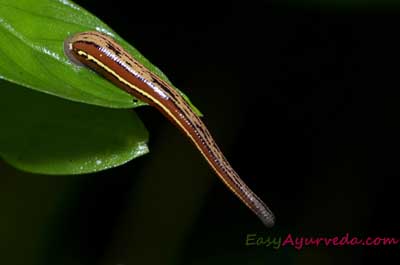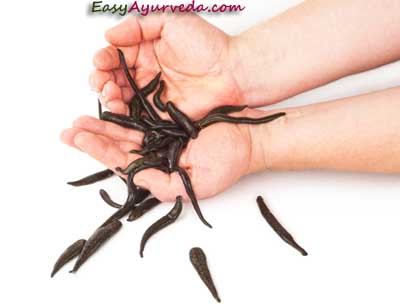Leech Therapy Procedure, Benefits, Side Effects, Treatment
Article by – Dr Renita D’Souza
Leech therapy or hirudotherapy is the method of removing impure blood from the body using medicinal leech. It is considered as the most easy and convenient method of Blood Letting Therapy (Rakthamokshana), which is one among the Panchakarma( Five purificatory procedure).
Leech therapy, also known as Jalooka avacharana is an ancient mode of blood letting.
Table of Contents
Jalauka definition
Nirukti of Jalayuka – (definition of leech)
Jala – water
Aayu – Life
As they are accustomed to water, they are called Jalayuka.

Leech modern view
Phylum – Annelida
Class – Hirudinea
Scientific name – Hirudo medicinalis
Habitat – Water
Indications
Indications for Leech Therapy:
Blood vitiated with pitta dosha
Children, old aged, frightful, debilitated, women and person with tender constitution
Diabetic ulcers
Varicose veins
Vatarakta (Gout)
Sciatica, lumbar spondylosis,
Acne
Osteoarthritis
Chronic skin conditions like eczema, psoriasis.
Abscess
Tumors of abdomen (Gulma)
Herpes
Poison
Hemorrhoids
diseases of neck and eyes
Therapeutic actions
Therapeutic Action of Jalouk Therapy:
Anti inflammatory
Increases blood circulation
Analgesic (reduces pain)
Thromolytic (dissolves blood clot)
Antimicrobial activity
Method of leech application
Method of application of leech –
Preparation of leech – Selected leeches should be smeared with paste of mustard and turmeric,then kept in water pot for 48 minutes. Active leech is selected and picked out to keep in separate water pot.
Procedure of Jalaukavacharana
The patient is made to sit or lie down, affected area is washed with antiseptic solution and roughened with smooth cow dung powder. Then the selected leech is kept over the affected area to bite and suck the blood. And retained with soft, white, moist cotton cloth is kept over it. With the appearance of pricking pain and itching at the site of the bite, it is to understood that leech is sucking pure blood, then it should be removed by sprinkling salt over its mouth.
Post therapy procedure – At the site of bite, turmeric is applied to arrest the bleeding.

How to know the leech is biting the affected area?
when it makes its mouth in the shape of a horse’s hoof, and lifts its neck then it is to be understood as biting, it should be covered with a moist cloth and retained.
What to do if leech does not bite the affected area?
If it does not bite, a drop of milk or blood is put at its mouth or small incision is made over the affected area. Inspite of all these procedure if it does not bite, then another leech is applied(discarding the earlier one).
What to do if the impure blood not expelled out completely?
When in doubt if impure blood not expelled out completely then, the site of bite should be made to bleed by applying the paste of turmeric, jaggery and honey.
Later the piece of cloth soaked in Shatha Dhautha Gritha or cooling pastes prepared from cold potency drugs should be applied over the site.
With the removal of vitiated blood, the redness and pain subside immediately.
Retaining leech after therapy
Leech is made to vomit the sucked blood out. It is sprinkled over with rice flour, so its held firmly, with left hand at its tail end and with right thumb and index its body kneaded slowly in downward direction to vomit the sucked blood. To assess if the vomiting is complete, keep the leech in pot of water, if leech movement is slow it indicates incomplete vomiting and if it moves quickly it ensures vomiting is complete. It is retained in fresh water.
Indramada
Disease of leech :
Leech suffers from Indramadha disease, if blood is not completely vomited out from leech.
Amount of blood sucked by leech:
5- 15 ml of blood
Leech types
Types of leeches: 12 types
6 Poisonous – Krishna, Karbura, Alagardha, Indraudha, Samudrika, Gochandana
6 Non poisonous – Kapila, Pingala, Sankhamuki (mouth resembling conch shell), Mooshika (resembling rat), Pundareekamuki (mouth resembling lotus), Savarika
Complications, treatment
Complications due to use of poisonous leech:
Bleeding, irritation, rashes, itching, fever.
Treatment:
‘Mahaghrutha’ can be applied internally and externally.
Symptomatic treatment
Unsuitable leeches
Leeches not suitable for therapy:
According to Acharya Sushrutha, leeches which are big in their middle(abdomen), ugly appearance, thick, slow in their movements, which do not bite, sucks little quantity of blood and which are poisonous.
Also leeches which have not vomited blood completely, when they are applied frequently and are inactive in water should be rejected.
Leech rearing
Rearing of leeches – Jalauka poshana –
They are placed in a big pot containing water of ponds or tanks along with their slit.
Food of leeches – powder of algae, dreid meat of acquatic animals and tubers should be put in water.
Straw, leaves of aquatic plants serve as bed for sleeping.
Changing of water and pot – Water and food in the pot should be changed once in every three days and pot is changed once in every seven days.
Leech habitat
Habitat of Non poisonous leech :
They are found in Yavana, Pandya (South India), Sahya (Central India) and Pautana (region around Mathura in U.P).
Those leeches which are born from decayed lotus, lily, algae and which live in clean water are non – poisonous and those which are born from the urine, excreta and decayed dead bodies of poisonous fish ,insects, fish, worms, frogs and which live in dirty water are poisonous.
Savisha Jalauka
Characteristics of poisonous leeches(Savisha jalooka):
Krishna – charecterised by black color and thick head.
Karbura – thier bodies are elongated as Varmi fish and abdomen is segmented and buldges out.
Alagardha – they are hairy, thick and round at the sides with black mouth.
Indraudha – they have lines at the sides of the body resembling to that of rainbow.
Samudrika – they are yellowish black in color and having floral patterns all over their body.
Gochandana – they have narrow mouth and their lower end resembles scrotal sac of the bull.
Nirvisha Jalauka
Characteristics of non poisonous leeches (nirvisha jalauka)
Kapila – they are smooth, have color of green gram(green) on the back. They have lines on the sides with the color of realgar(orange).
Pingala – they have round body, slight red color, they move and suck blood quickly.
Shankamuki – they are reddish brown in color with elongated sharp mouth which enables to suck blood swiftly.
Mooshika – they are similar to mice in shape, color and smell.
Pundareekamuki – they are colored like green gram(green) and mouth is similar to lotus flower.
Savarika – they are smooth with color of lotus leaf (green) and having length of 18 angula. They are used for blood letting in animals especially cattle.
Cost of leech therapy – It largely depends on the number of leeches to be used per therapy Usually it varies between 500 -1,500 rupees per sitting.
Click to Consult Dr Renita D’Souza










One comment
Karthik
Can this procedure completely cure varicose veins